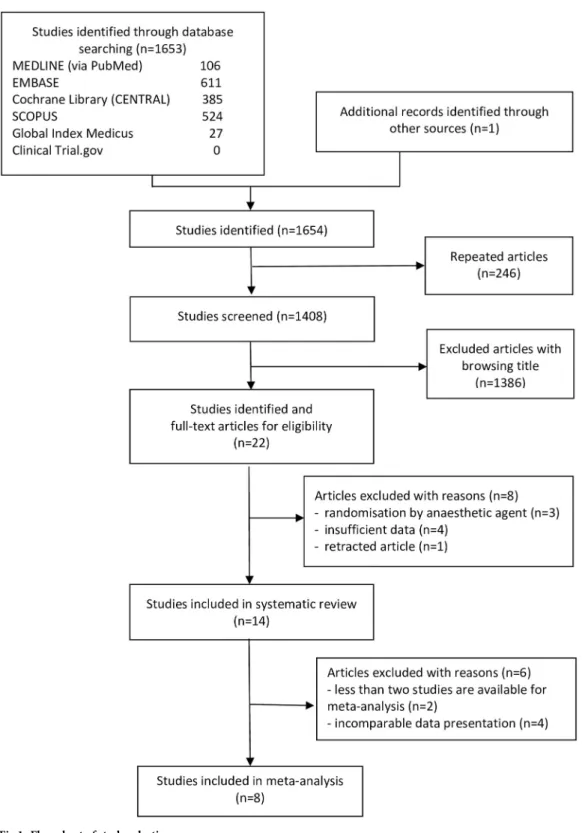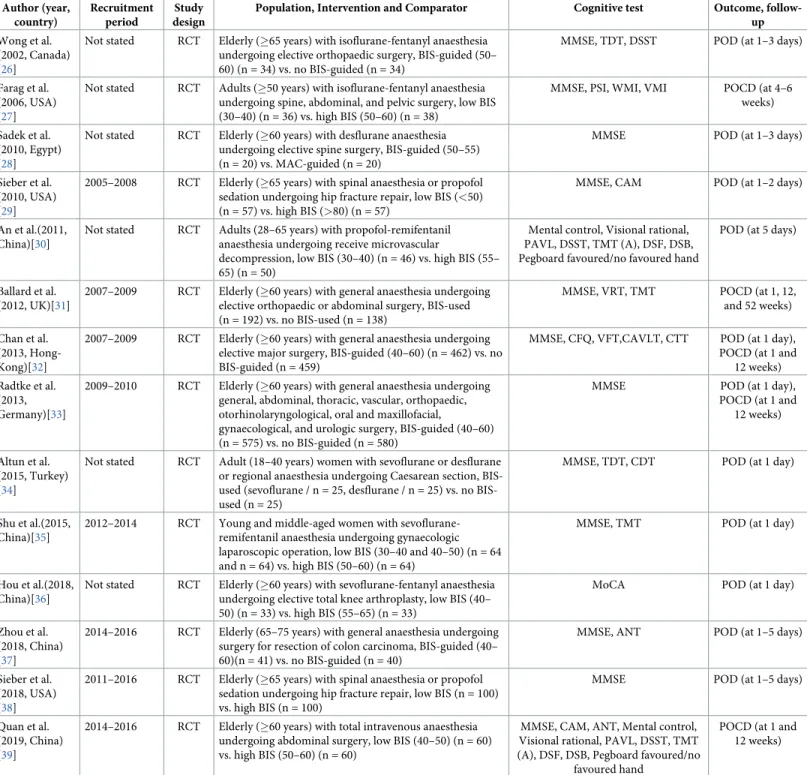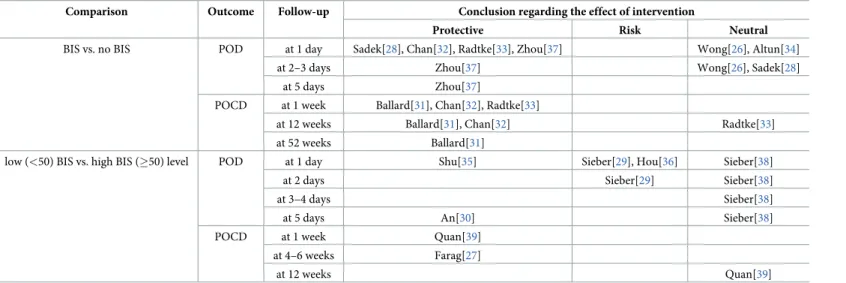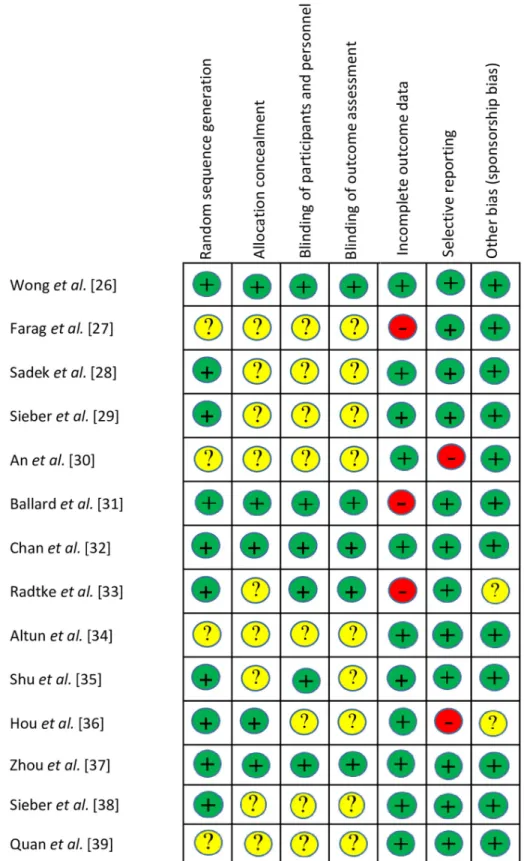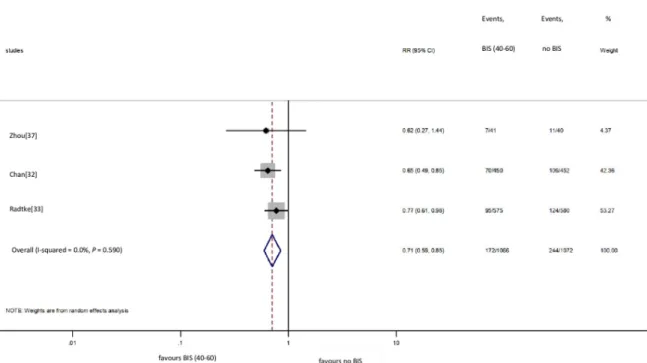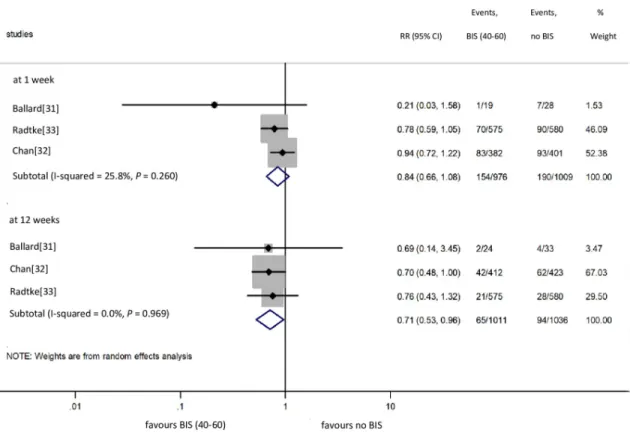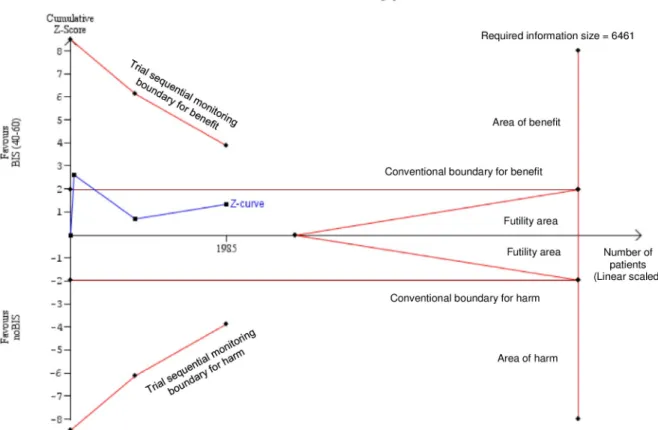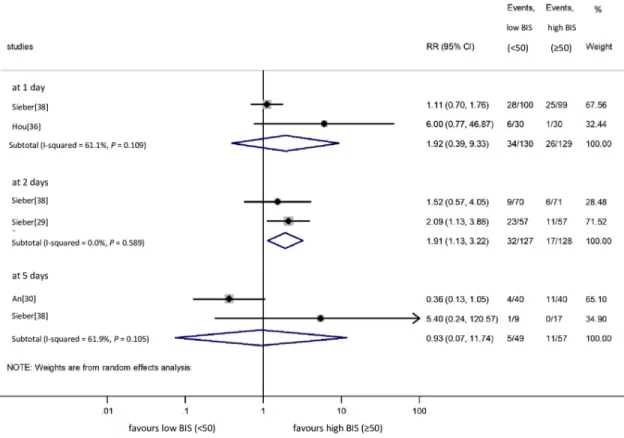Is the bispectral index monitoring protective against postoperative cognitive decline? A systematic review with meta-analysis
Timea BocskaiID1, Ma´rton Kova´cs2, Zsolt Szaka´csID3,4, Noe´mi Gede3, Pe´ter Hegyi3,4,5,6, Ga´bor Varga7, Istva´n Pap2, Istva´n To´ th2, Pe´ter Re´ve´sz2, Istva´n Szanyi2, Adrienne Ne´meth2, Imre Gerlinger2, Ka´zme´r Kara´di8☯, La´szlo´ Lujber2☯*
1 Department of Anaesthesiology and Intensive Care, Medical School, University of Pe´cs, Pe´cs, Hungary, 2 Department of Otorhinolaryngology (ENT), Medical School, University of Pe´cs, Pe´cs, Hungary, 3 Institute for Translational Medicine, Medical School, University of Pe´cs, Pe´cs, Hungary, 4 Ja´nos Szenta´ gothai Research Center, University of Pe´cs, Pe´cs, Hungary, 5 Division of Gastroenterology, First Department of Medicine, Medical School, University of Pe´cs, Pe´cs, Hungary, 6 Hungarian Academy of Sciences–University of Szeged, Momentum Gastroenterology Multidisciplinary Research Group, Szeged, Hungary, 7 Department of Oral Biology, Semmelweis University, Budapest, Hungary, 8 Institute of Behavioral Sciences, Medical School, University of Pe´cs, Pe´cs, Hungary
☯These authors contributed equally to this work.
*lujber@gmail.com
Abstract
Background
Several studies have suggested that monitoring the depth of anaesthesia might prevent the development of postoperative cognitive decline. We aimed to conduct a meta-analysis to investigate the effects of bispectral index (BIS) monitoring in anaesthesia.
Methods
We searched in six major electronic databases. Trials were included if they discussed anaesthesia with and without BIS monitoring or low (<50) and high (�50) BIS levels and which measured the risk of postoperative delirium (POD) and/or postoperative cognitive dysfunction (POCD).
Results
We included fourteen studies in the systematic review, eight of which were eligible for meta- analysis. BIS proved to be protective against POD at 1 day postoperatively in a cohort of 2138 patients (16.1% vs. 22.8% for BIS vs. no BIS groups, respectively; relative risk [RR]
0.71; 95% confidence interval [CI] 0.59 to 0.85, without significant between-study heteroge- neity I2= 0.0%, P = 0.590). The use of BIS was neutral for POCD at 1 week but protective for POCD at 12 weeks (15.8% vs. 18.8% for BIS vs. no BIS groups, respectively; RR = 0.84, CI: 0.66 to 1.08), without significant between-study heterogeneity (I2= 25.8%, P = 0.260).
The neutral association at 1 week proved to be underpowered with trial sequential analysis.
In the comparison of low BIS versus high BIS, the incidence of POD at 1 day was similar in the groups.
a1111111111 a1111111111 a1111111111 a1111111111 a1111111111
OPEN ACCESS
Citation: Bocskai T, Kova´cs M, Szaka´cs Z, Gede N, Hegyi P, Varga G, et al. (2020) Is the bispectral index monitoring protective against postoperative cognitive decline? A systematic review with meta- analysis. PLoS ONE 15(2): e0229018.https://doi.
org/10.1371/journal.pone.0229018 Editor: Ehab Farag, Cleveland Clinic, UNITED STATES
Received: October 18, 2019 Accepted: January 28, 2020 Published: February 13, 2020
Peer Review History: PLOS recognizes the benefits of transparency in the peer review process; therefore, we enable the publication of all of the content of peer review and author responses alongside final, published articles. The editorial history of this article is available here:
https://doi.org/10.1371/journal.pone.0229018 Copyright:©2020 Bocskai et al. This is an open access article distributed under the terms of the Creative Commons Attribution License, which permits unrestricted use, distribution, and reproduction in any medium, provided the original author and source are credited.
Data Availability Statement: All relevant data are within the manuscript and its Supporting Information files.
Conclusion
Our findings suggest a protective effect of BIS compared to not using BIS regarding the inci- dence of POD at 1 day and POCD at 12 weeks. However, limitations of the evidence warrant further investigation to identify those groups of patients by age, comorbid conditions and other individual variables who would benefit the most from the use of BIS monitoring.
Introduction
The disturbance in cognitive brain activity after surgery under general anaesthesia is worri- some. According to the literature, the incidence of cognitive decline after minor or major sur- geries ranges from 7 to 29% in the elderly and even reaches 19% in younger patients as well [1–4]. A prominently high incidence was observed after heart surgery (80%) [5].
The aetiology of postoperative cognitive decline is multifactorial [1–4,6–9]. Considering the causes of postoperative delirium (POD) and postoperative cognitive dysfunction (POCD), the predisposing factors are very similar [1,2,6,7]. However, important differences may be found in the pathophysiological background [2,6]. By definition, POD is an acute deteriora- tion in cognitive function, a disturbance of consciousness. It develops in the early days postop- eratively [2,6,7,10,11]. POCD is one of the adverse effects of anaesthesia which develops in the later postoperative period and manifests as a decline in a patient’s cognitive abilities [2,6, 7,10]. Several neuropsychological tests are available to detect changes of cognitive function, although proper test assessment and interpretation are often problematic [2,8].
Prevention of postoperative cognitive disturbances is a top priority, with one potential tool being the application of bispectral index (BIS) monitoring [2,6,7,9,12–14]. Previous system- atic reviews have yielded discrepant results, although the methods applied in data collection, selection and pooling have been varied and, sometimes, incomplete as well [15–19]. These reviews have left the question open on how BIS monitor-guided anaesthesia influences the incidence of POD and POCD.
Our aim was to compile all available evidence on the effects of BIS on POD and POCD in a systematic review with meta-analysis using two comparisons: general anaesthesia with or with- out BIS monitoring and anaesthesia with low (BIS values<50) or high (BIS values�50) BIS levels.
Materials and methods
Our study is a systematic review with a meta-analysis of randomized controlled trials (RCTs) evaluating the effect of BIS monitoring on patients under general anaesthesia in the prevention of POD and POCD. Our publication adheres to the PRISMA Statement [20].
PICOS and eligibility
The review question was formulated by the PICO framework. We included studies that discuss (Population) adult patients who underwent general anaesthesia (Intervention1vs. Compara- tor1) with BIS monitoring vs. without BIS monitoring or (Intervention2vs. Comparator2) with low vs. high BIS and which measure (Outcome) the risk of POD and/or POCD. (Study design) As regards study design, we included RCTs exclusively.
A BIS value is a number on a spectrum between 0 and 100 without dimension, scaled to correlate with important clinical endpoints and electroencephalographic (EEG) signals under
Funding: This study was supported by an Economic Development and Innovation Operative Program Grant (GINOP 2.3.2-15-2016-00048) and an Institutional Developments for Enhancing Intelligent Specialization Grant (EFOP-3.6.2-16- 2017-0006) from the National Research, Development and Innovation Office. The funders had no role in study design, data collection and analysis, decision to publish, or preparation of the manuscript.
Competing interests: The authors have declared that no competing interests exist.
anaesthesia [7,12–14]. The upper end of the spectrum is the awake state with a typical BIS value near 100 [7,12]. The lower end (BIS = 0) is defined as an isoelectric EEG record [7,12].
The optimal BIS range of standard surgical anaesthesia falls between 40 and 60 [7,12–14]. This range can be divided into low (<50) and high (�50) BIS levels.
We defined POD as a complete disturbance affecting the integrity of consciousness in the first 1–5 days after surgery, whereas POCD begins days later from 1 week on and may persist for 4–6 weeks or even longer, up to 52 weeks [2–4,10]. Our primary outcome was POD at 1 day, while secondary outcomes included POD at 2, 3, 4 and 5 days as well as POCD at 1, 12 and 52 weeks.
Search, selection and data extraction
We searched electronic databases including MEDLINE (via PubMed), EMBASE, Cochrane Controlled Register of Trials (CENTRAL), SCOPUS, WHO Global Health Library/Global Index Medicus and Clinical Trial.gov for relevant articles from inception up to 29 April 2019.
Human and English-language filters were imposed on the search, where appropriate. Further details of search, selection and data extraction are shown inS1 Appendix. We did not contact the original authors for further information.
Risk of bias (RoB) assessment
We used the Cochrane Risk of Bias Tool to rate risk of bias along critical points in methodol- ogy (PH, GV, IP and IT) [21].
Results from the RoB assessment were incorporated into the interpretation of findings but not in statistical analysis (KK). Discrepancies during the assessment were resolved by reaching a consensus.
Quality of evidence
We used the Grading of Recommendations, Assessment, Development and Evaluation (GRADE) approach to rate the quality of evidence on each outcome (ZS) [22].
Statistical analysis
The statistical analysis was performed using Stata 15 SE (Stata Corp) by an expert statistician (NG). We calculated pooled relative risks (RRs) with 95% confidence intervals (CIs) for POD and POCD [23]. The analysis was done according to the timing of neuropsychological test measurements (that is, POD at 1, 2 and 5 days and POCD at 1 and 12 weeks). We only per- formed statistical analysis if at least two RCTs per group were available. Since the settings of the studies do not match exactly, we applied the random effect model with the DerSimonian–
Laird estimation [24]. I2and chi2tests were used to quantify statistical heterogeneity and obtainP-values, respectively;P<0.100 indicated a significant heterogeneity [24]. To evaluate the effect of the individual studies on the pooled estimate, sensitivity analysis was conducted by omitting studies one by one from the analysis if at least three studies were available per anal- ysis. Trial sequential analysis (TSA) was used to quantify the statistical reliability of data if the condition of the tests were met [25].
Since the number of studies included in the analysis was low, publication bias could not be checked either using graphical tools (e.g. funnel plots) or tests (e.g. Egger’s test).
Study protocol and protocol deviations
The protocol for this study was registered in PROSPERO a priori under registration number CRD42018092981, protocol deviations are described inS1 Appendix.
Results
Identification and characteristics of the studies
Fig 1shows the flow chart of our meta-analysis. In total, we identified 1653 records through database searches and one record through other sources; 1408 of which were screened for eligi- bility after removing duplicates. A total of 1386 ineligible studies were eliminated after brows- ing titles. Twenty-two studies were removed based on abstract screening. Finally, fourteen studies were included in the systematic review [26–39] eight of which [29–33,36–38] were qualified to be in the meta-analysis (for reasons, seeFig 1).
The characteristics of the studies included and those excluded on full-text assessment are summarised inTable 1[26–39] andS1 Table[40–47], respectively.
Conclusions from studies included in the systematic review are summarised inTable 2[26–
39] with detailed results presented inS2andS3Tables.
The Summary of findings table provides a brief synopsis of the analyses (Table 3).
RoB
Although selective reporting was scarce, most items did not meet the criteria for low RoB;
these include random sequence generation, allocation concealment and blinding. Three out of fourteen studies were considered to be at high risk in terms of incomplete data reporting. RoB of the included RCTs is summarised in Figs2and3.
BIS vs. no BIS: POD
We included three [32,33,37] studies in the meta-analysis on POD (Fig 4). Based on pooled data from 2138 cases, the use of BIS did prevent POD 1 day after surgery (16.1% vs. 22.8% for BIS vs. no BIS groups, respectively; RR = 0.71, CI: 0.59 to 0.85 for BIS vs. no BIS comparison), without significant between-study heterogeneity (I2= 0.0%,P= 0.590) [32,33,37].
Two studies [28,37] based on data from 121 patients showed that the use of BIS did seem to prevent POD within 1–5 days after surgery. In contrast, findings from two studies [26,34]
involving 135 patients showed a neutral effect of the use of BIS monitoring.
BIS vs. no BIS: POCD
We included three [31–33] studies in the meta-analysis on POCD (Fig 5). Based on pooled data from 1985 cases, the use of BIS did not prevent POCD 1 week after surgery (15.8% vs.
18.8% for BIS vs. no BIS groups, respectively; RR = 0.84, CI: 0.66 to 1.08 for BIS vs. no BIS comparison), without significant between-study heterogeneity (I2= 25.8%,P= 0.260) [31–33].
The neutral association calculated from the data from 1985 cases proved to be underpowered (indicated by TSA) and therefore insufficient to draw a final conclusion (Fig 6). Based on the pooled data from 2047 cases, the use of BIS did prevent POCD 12 weeks after surgery (6.4%
vs. 9.1% for BIS vs. no BIS groups, respectively; RR = 0.71, CI: 0.53 to 0.96 for BIS vs. no BIS comparison), again, without significant between-study heterogeneity (I2= 0.0%,P= 0.969) [31–33]. Only one study [31] involving 60 patients in groups reported data of POCD 52 weeks after surgery (3.7% vs. 12.5% for BIS vs. no BIS groups, respectively;P= 0.36), indicating no benefit of the intervention.
Two studies [31,32] with multiple cognitive tests and 154 cases reported a preventive effect of BIS POCD at 1, 12 and 52 weeks.
S2 Tablesummarises the results of studies reporting on the BIS vs. no BIS comparison for POD and POCD.
Fig 1. Flow chart of study selection.
https://doi.org/10.1371/journal.pone.0229018.g001
Table 1. Characteristics of the studies included.
Author (year, country)
Recruitment period
Study design
Population, Intervention and Comparator Cognitive test Outcome, follow- up Wong et al.
(2002, Canada) [26]
Not stated RCT Elderly (�65 years) with isoflurane-fentanyl anaesthesia undergoing elective orthopaedic surgery, BIS-guided (50–
60) (n = 34) vs. no BIS-guided (n = 34)
MMSE, TDT, DSST POD (at 1–3 days)
Farag et al.
(2006, USA) [27]
Not stated RCT Adults (�50 years) with isoflurane-fentanyl anaesthesia undergoing spine, abdominal, and pelvic surgery, low BIS (30–40) (n = 36) vs. high BIS (50–60) (n = 38)
MMSE, PSI, WMI, VMI POCD (at 4–6 weeks) Sadek et al.
(2010, Egypt) [28]
Not stated RCT Elderly (�60 years) with desflurane anaesthesia undergoing elective spine surgery, BIS-guided (50–55) (n = 20) vs. MAC-guided (n = 20)
MMSE POD (at 1–3 days)
Sieber et al.
(2010, USA) [29]
2005–2008 RCT Elderly (�65 years) with spinal anaesthesia or propofol sedation undergoing hip fracture repair, low BIS (<50) (n = 57) vs. high BIS (>80) (n = 57)
MMSE, CAM POD (at 1–2 days)
An et al.(2011, China)[30]
Not stated RCT Adults (28–65 years) with propofol-remifentanil anaesthesia undergoing receive microvascular
decompression, low BIS (30–40) (n = 46) vs. high BIS (55–
65) (n = 50)
Mental control, Visional rational, PAVL, DSST, TMT (A), DSF, DSB, Pegboard favoured/no favoured hand
POD (at 5 days)
Ballard et al.
(2012, UK)[31]
2007–2009 RCT Elderly (�60 years) with general anaesthesia undergoing elective orthopaedic or abdominal surgery, BIS-used (n = 192) vs. no BIS-used (n = 138)
MMSE, VRT, TMT POCD (at 1, 12,
and 52 weeks) Chan et al.
(2013, Hong- Kong)[32]
2007–2009 RCT Elderly (�60 years) with general anaesthesia undergoing elective major surgery, BIS-guided (40–60) (n = 462) vs. no BIS-guided (n = 459)
MMSE, CFQ, VFT,CAVLT, CTT POD (at 1 day), POCD (at 1 and
12 weeks) Radtke et al.
(2013, Germany)[33]
2009–2010 RCT Elderly (�60 years) with general anaesthesia undergoing general, abdominal, thoracic, vascular, orthopaedic, otorhinolaryngological, oral and maxillofacial,
gynaecological, and urologic surgery, BIS-guided (40–60) (n = 575) vs. no BIS-guided (n = 580)
MMSE POD (at 1 day),
POCD (at 1 and 12 weeks)
Altun et al.
(2015, Turkey) [34]
Not stated RCT Adult (18–40 years) women with sevoflurane or desflurane or regional anaesthesia undergoing Caesarean section, BIS- used (sevoflurane / n = 25, desflurane / n = 25) vs. no BIS- used (n = 25)
MMSE, TDT, CDT POD (at 1 day)
Shu et al.(2015, China)[35]
2012–2014 RCT Young and middle-aged women with sevoflurane- remifentanil anaesthesia undergoing gynaecologic laparoscopic operation, low BIS (30–40 and 40–50) (n = 64 and n = 64) vs. high BIS (50–60) (n = 64)
MMSE, TMT POD (at 1 day)
Hou et al.(2018, China)[36]
Not stated RCT Elderly (�60 years) with sevoflurane-fentanyl anaesthesia undergoing elective total knee arthroplasty, low BIS (40–
50) (n = 33) vs. high BIS (55–65) (n = 33)
MoCA POD (at 1 day)
Zhou et al.
(2018, China) [37]
2014–2016 RCT Elderly (65–75 years) with general anaesthesia undergoing surgery for resection of colon carcinoma, BIS-guided (40–
60)(n = 41) vs. no BIS-guided (n = 40)
MMSE, ANT POD (at 1–5 days)
Sieber et al.
(2018, USA) [38]
2011–2016 RCT Elderly (�65 years) with spinal anaesthesia or propofol sedation undergoing hip fracture repair, low BIS (n = 100) vs. high BIS (n = 100)
MMSE POD (at 1–5 days)
Quan et al.
(2019, China) [39]
2014–2016 RCT Elderly (�60 years) with total intravenous anaesthesia undergoing abdominal surgery, low BIS (40–50) (n = 60) vs. high BIS (50–60) (n = 60)
MMSE, CAM, ANT, Mental control, Visional rational, PAVL, DSST, TMT (A), DSF, DSB, Pegboard favoured/no
favoured hand
POCD (at 1 and 12 weeks)
RCT: randomised controlled trial; BIS: bispectral index; MAC: Minimal Alveolar Concentration; MMSE: Mini Mental State Examination; TDT: Trieger Dot Test; DSST:
Digit Symbol Substitution Test; PSI: Parenting Stress Inventory; WMI: Working Memory Index; VMI: Visual Motor Integration Test; CAM: Confusion Assessment Method; PAVL: Paired Associate Verbal Learning; TMT: Trail Making Test; DSF: Digit Span Forward; DSB: Digit Span Backward; VRT: Vigilance Reaction Time; CFQ:
Cognitive Failure Questionnaire; VFT: Verbal Fluency Test; CAVLT: Chinese Auditory Verbal Learning; CTT: Color Trial Test; CDT: Clock Drawing Test; MoCA:
Montreal Cognitive Assessment; ANT: Attention Network Test; POD: postoperative delirium; POCD: postoperative cognitive dysfunction.
https://doi.org/10.1371/journal.pone.0229018.t001
Table 2. Summary of the conclusions of the studies included.
Comparison Outcome Follow-up Conclusion regarding the effect of intervention
Protective Risk Neutral
BIS vs. no BIS POD at 1 day Sadek[28], Chan[32], Radtke[33], Zhou[37] Wong[26], Altun[34]
at 2–3 days Zhou[37] Wong[26], Sadek[28]
at 5 days Zhou[37]
POCD at 1 week Ballard[31], Chan[32], Radtke[33]
at 12 weeks Ballard[31], Chan[32] Radtke[33]
at 52 weeks Ballard[31]
low (<50) BIS vs. high BIS (�50) level POD at 1 day Shu[35] Sieber[29], Hou[36] Sieber[38]
at 2 days Sieber[29] Sieber[38]
at 3–4 days Sieber[38]
at 5 days An[30] Sieber[38]
POCD at 1 week Quan[39]
at 4–6 weeks Farag[27]
at 12 weeks Quan[39]
BIS: bispectral index; POD: postoperative delirium; POCD: postoperative cognitive dysfunction https://doi.org/10.1371/journal.pone.0229018.t002
Table 3. Summary of findings table.
P: patients who underwent general anaesthesia, I: BIS monitoring, C: no BIS monitoring, O: postoperative cognitive performance (POD and POCD)
Outcomes Illustrative comparative risk Relative effect (95%
CI)
No. of participants (studies)
Quality of evidence (GRADE) BIS monitoring no BIS monitoring
POD at 1 day (raw data) 16.1 per 100 patients
22.8 per 100 patients
RR: 0.71 (0.59–0.85) 2138 (3) ●●○○1low
POCD at 1 week (raw data) 15.8 per 100 patients
18.8 per 100 patients
RR: 0.84 (0.66–1.08) 1985 (3) ●○○○2very low
POCD at 12 weeks(raw data) 6.4 per 100 patients 9.1 per 100 patients RR: 0.71 (0.53–0.96) 2047 (3) ●○○○3very low POCD at 52 weeks (raw
data)
3.7 per 100 patients 12.5 per 100 patients
RR: 0.32 (0.04–2.72) 59 (1) ●○○○4very low
P: patients who underwent general anaesthesia, I: low level of BIS, C: high level of BIS, O: postoperative cognitive performance (POD and POCD)
Outcomes Illustrative comparative risk Relative effect (95%
CI)
No. of participants (studies)
Quality of evidence (GRADE) low level of BIS high level of BIS
POD at 1 day (raw data) 26.2 per 100 patients
20.1 per 100 patients
RR: 1.92 (0.39–9.33) 259 (2) ●○○○5very low
POCD at 1 week (raw data) 19.2 per 100 patients
10.3 per 100 patients
RR: 0.52 (0.27–1.00) 105 (1) ●○○○6very low
POCD at 12 weeks (raw data)
39.6 per 100 patients
14.6 per 100 patients
RR: 0.73 (0.22–2.41) 83 (1) ●○○○7very low
POCD at 52 weeks no data no data no data
1downgraded one level for risk of bias and one level for indirectness;
2downgraded two levels for risk of bias and one level for imprecision;
3downgraded two levels for risk of bias and one level for indirectness;
4dowgraded one level for risk of bias and two levels for imprecision;
5downgraded two levels for risk of bias, two levels for imprecision and one level for indirectness;
6downgraded one level for risk of bias and two levels for imprecision;
7downgraded one level for risk of bias, two levels for imprecision and one level for indirectness.
BIS: bispectral index; CI: confidence interval; RR: relative risk; POD: postoperative delirium; POCD: postoperative cognitive dysfunction.
https://doi.org/10.1371/journal.pone.0229018.t003
Fig 2. Risk of bias table. RCT: randomised controlled trial; "+": low risk of bias; "?": unclear risk of bias; "−": high risk of bias.
https://doi.org/10.1371/journal.pone.0229018.g002
Low BIS vs. high BIS: POD
We included four [29,30,36,38] studies in the meta-analysis on POD. Data were available in two studies for POD at 1 day [36,38], POD at 2 days [29,37] and POD at 5 days [30,38]. As
Fig 3. Risk of bias graph.
https://doi.org/10.1371/journal.pone.0229018.g003
Fig 4. Risk of POD at 1 day with BIS vs. without BIS monitoring. POD: postoperative delirium; BIS: bispectral index; RR: relative risk;
Cl: confidence interval.
https://doi.org/10.1371/journal.pone.0229018.g004
demonstrated inFig 7, low BIS did not change the risk of POD at 1 and 5 days, while high BIS proved to be favourable at 2 days (RR = 1.91, CI: 1.13 to 3.22 for the low BIS vs. high BIS com- parison), without significant between-study heterogeneity (I2= 0.0%,P= 0.589).
One study [29] involving 114 patients reported no significant difference in Mini Mental State Examination (MMSE) between groups for POD at 2 days (20.0±9.3 in the low BIS group vs. 23.1±5.5 in the high BIS group;P= 0.08). Another study [35] involving 192 patients attributed a protective effect to low BIS for POD at 1 dayP= 0.006 for MMSE scores and P= 0.01 for TMT (Trail Making Test) scores.
Low BIS vs. high BIS: POCD
Only one study [39] involving 120 patients presented data on POCD at 1 week. Results from groups were significantly different for POCD at 1 week (19.2% in the low BIS group vs. 39.6%
in the high BIS group;P= 0.032) and were similar at 12 weeks (10.3% in the low BIS group vs.
14.6% in the high BIS group;P= 0.558).
Two studies [27,39] involving 154 patients reported similar results on POCD at 1 [27] and 4–6 weeks [39] after surgery. These studies demonstrated a protective effect of lower BIS on POCD. Only one study [39] reported no significant difference between the effects of different BIS levels at 12 weeks.
S3 Tableillustrates the results of postoperative cognitive performance tests for the low BIS vs. high BIS comparison.
Fig 5. Risk of POCD at 1 and 12 weeks with BIS vs. without BIS monitoring. POCD: postoperative cognitive dysfunction; BIS:
bispectral index; RR: relative risk; Cl: confidence interval.
https://doi.org/10.1371/journal.pone.0229018.g005
Sensitivity analysis
Results for POD at 1 day and POCD at 1 week remained unchanged if any studies were removed from the analysis. However, we lost significance if we removed the Chan et al. study from the analysis on POCD at 12 weeks (probably due to the lack of statistical power).
Discussion
Appropriate brain function monitoring (electroencephalogram monitoring and depth of anaesthesia) would be important to ensure personalised, patient-specific anaesthesia. Theoreti- cally, the application of BIS monitoring could reduce the incidence of prolonged recovery and delayed return of normal cognitive abilities (i.e., orientation and other cognitive functions). A quick and safe postoperative cognitive recovery, such as the avoidance of POD, is of critical importance for patient safety, reduction, and prevention of postoperative complications, early mobilisation and discharge and cost-effectiveness of surgery [2,6,7,9]. POCD starts from the end of the first postoperative week and may persist for weeks to months [2,11]. POCD impairs quality of life and reduces the Quality-Adjusted life-year (QALY) [11].
Fig 6. Trial sequential analysis of data in the BIS vs. no BIS monitoring anaesthesia comparison for the outcome of POCD. Trial sequential analysis (TSA) is a random effect-based meta-analytical model to estimate the "required information size"; in other words, the required meta-analytical sample size allowing us to draw a confident conclusion. Each dot on the Z-curve represents a new piece of information, the results of a new randomised study (a total of three studies were used in our case). If the Z-curve crosses the futility boundary, the intervention has no significant effect on the outcome and the results are unlikely to change if further studies are added. If the Z-curve, crosses the significance boundaries, the intervention has a significant effect on the outcome. In our case, neither the conventional significance boundary nor trial sequential significance boundary was crossed by the cumulative Z-curve indicating that the meta-analytical sample size (1985 patients) is insufficient to draw a confident conclusion: further studies are needed until the "required information size"
(6461 patients) is reached. BIS: bispectral index; POCD: postoperative cognitive dysfunction.
https://doi.org/10.1371/journal.pone.0229018.g006
Several trials have been conducted to date to evaluate the benefit of BIS monitoring under anaesthesia to prevent POD and POCD (Table 2); however, they have yielded discrepant con- clusions (Table 3). Our aim was to summarise the true benefits of BIS monitoring by conduct- ing a meta-analysis with a systematic review.
Our findings provide low quality of evidence that the use of BIS monitoring was superior to not using BIS for POD at 1 day and for POCD at 12 weeks (very lowquality of evidence). How- ever, the beneficial effects remained undetected for POCD at 1 week, although the analysis was underpowered (see TSA inFig 6). (very lowquality of evidence) (Table 3). In addition, low BIS seems to be protective against POD at 2 days and maybe against POCD at 1 week (very low grade of evidence for both) (Fig 7,Table 3).
Three previous meta-analyses [15–17] and two systematic reviews [18,19] have investigated the association between the depth of anaesthesia and cognitive impairment. Lu et al. [15] com- pared low BIS and high BIS groups in four studies and concluded that the depth of anaesthesia did not correlate with the risk of POCD, but deep anaesthesia carried a significantly increased risk of POD. In their meta-analysis, the number of eligible studies was relatively low and the merged results on the outcomes were inconsistent. Oliveira et al. [16] demonstrated that BIS monitoring is favourable for POD and POCD at 1 month, as opposed to POCD at 1 week. How- ever, in the latter case, data collection might be compromised since neither event numbers nor total number of patients included in analyses match that reported by the original Chan et al.
article for POCD [30]. When pooling dichotomous and continuous outcomes, Mackenzie et al.
[17] found that electroencephalogram-guided anaesthesia was associated with a reduction in POD incidence. Luo and Zou reported similar results as Mackenzie [17] on the association of
Fig 7. Risk of POD at 1, 2 and 5 days with low BIS vs. high BIS monitoring. POD: postoperative delirium; BIS: bispectral index;
RR: relative risk; Cl: confidence interval.
https://doi.org/10.1371/journal.pone.0229018.g007
BIS- and AEP-controlled anaesthesia with POD. Furthermore, a significant association was found with regard to the reduction of long-term cognitive decline. They identified significant heterogeneity across studies but ORs were similar for cardiac and no-cardiac surgeries [18].
Orena et al. concluded based on their research and currently available data that the use of intrao- perative anaesthesia depth monitor is recommended during lighter sedation. Furthermore, the prudent use of premedications was also highlighted [19]. Contrasting these studies, we separated dichotomous and continuous data in the analysis, complemented the list of included studies with new ones and used TSA to decide whether not observing a difference between groups can be attributed to the size of the sample (beta-type error) or to a true association.
Strengths and limitations
(1) This is the first comprehensive assessment to discuss the effect of BIS monitoring on both POD and POCD with rigorous evidence synthesis (as seen inTable 3). In our study, data were shorted to the time of sampling. (2) The main strength of this study is that we included RCTs exclusively [26,39]. (3) We conducted a comprehensive search with rigorous selection and RoB assessment (Figs2and3). (4) Our main comparisons included a homogenous data set;
therefore, confounding factors are unlikely to bias our results (see the I2and chi2tests results).
This contrasts with the fact that the measurement of cognitive performance is based due to the lack of uniform, comprehensive and ecologically valid tests.
Besides the strengths, the evidence acquired is limited for a number of reasons (Table 3).
(1) Although there are many publications, study protocols and data reporting are discrepant and incomplete (e.g. tests handled as continuous variables), thereby impeding statistical analy- sis. (2) There were mild differences in the definition of POD and POCD across studies, espe- cially in the execution of postoperative cognitive measurements, although this discrepancy did not cause statistical heterogeneity in most analyses. (3) Publication bias could not be assessed due to the low number of eligible studies included. (4) For the same reason, subgroup analyses would be inconclusive. (5) Statistical heterogeneity occurred in some analyses, a result which might be explained by clinical heterogeneity (e.g. indications and types of surgery) and methodological heterogeneity (e.g. perioperative medications). However, previous studies [42,43,47] have suggested that certain intraoperative anaesthetic agents (e.g. propofol or vola- tile gases) may not affect POD and POCD; therefore, they are unlikely to distort our results.
(6) Despite the high number of patients included, TSA on the BIS vs. no BIS comparison for POCD at 1 week indicated that neither the conventional significance boundary nor the trial sequential significance boundary was crossed by the cumulative Z-curve (Fig 6). The required sample size would thus be 6461 patients to draw a final conclusion, whereas our meta-analysis of three RCTs included only 1985 cases. (7) It is possible that the neutral association identified in the comparison of low BIS vs. high BIS regarding POD at 1 day is the consequence of beta- type error (Fig 7), which, unfortunately, could not be tested because the conditions of TSA were not met in this case.
Conclusion
BIS monitoring might have a protective effect against POD at 1 day and POCD at 12 weeks compared to not using BIS while low BIS seems to be favourable regarding the incidence of POD at 2 days and POCD at 1 week. Considering the grade of evidence, these findings call for further investigation to identify those patients by age, comorbid conditions, mental status, type of surgery and anaesthesia and by other individual variables who would benefit the most from the use of BIS or other entropy monitoring as well as to establish the optimal BIS value during anaesthesia.
Supporting information
S1 Table. Characteristics of the studies excluded.
(DOCX)
S2 Table. Parameters for the BIS vs. no BIS comparison for the results of postoperative cognitive performance to establish the diagnosis of POD and POCD.
(XLSX)
S3 Table. Parameters for the low BIS vs. high BIS comparison for the results of postopera- tive cognitive performance to establish the diagnosis of POD and POCD.
(XLSX)
S1 Appendix. Methodological details.
(DOCX)
S1 Checklist. PRISMA checklist.
(DOC)
Acknowledgments
The authors would like to express their gratitude to anaesthesiologists Professor Lajos Bogar and Professor Zsolt Molnar for the constructive criticism expressed about the manuscript, which significantly improved the paper.
Author Contributions Conceptualization: Timea Bocskai.
Data curation: Timea Bocskai, Ma´rton Kova´cs, Ka´zme´r Kara´di.
Formal analysis: Zsolt Szaka´cs, Noe´mi Gede, Pe´ter Hegyi, Ga´bor Varga, Istva´n Pap, Istva´n To´th.
Investigation: Zsolt Szaka´cs.
Methodology: Timea Bocskai, Zsolt Szaka´cs, Pe´ter Hegyi, Ga´bor Varga, Istva´n Pap, Istva´n To´th, Ka´zme´r Kara´di.
Project administration: Ma´rton Kova´cs.
Software: Ma´rton Kova´cs, Zsolt Szaka´cs, Noe´mi Gede.
Supervision: Zsolt Szaka´cs, Pe´ter Hegyi, Ga´bor Varga, Istva´n Pap, Istva´n To´th, Pe´ter Re´ve´sz, Istva´n Szanyi, Adrienne Ne´meth, Imre Gerlinger, Ka´zme´r Kara´di, La´szlo´ Lujber.
Visualization: Timea Bocskai, Ma´rton Kova´cs, Zsolt Szaka´cs, Pe´ter Re´ve´sz, Istva´n Szanyi, Adrienne Ne´meth, Imre Gerlinger.
Writing – original draft: Timea Bocskai, Zsolt Szaka´cs, La´szlo´ Lujber.
Writing – review & editing: La´szlo´ Lujber.
References
1. Hanning CD. Postoperative cognitive dysfunction. Br J Anaesth. 2005; 95: 82–87.https://doi.org/10.
1093/bja/aei062PMID:15640305
2. Monk TG, Price CC. Postoperative cognitive disorders. Curr Opin Crit Care. 2011; 17: 376–381.https://
doi.org/10.1097/MCC.0b013e328348becePMID:21716111
3. Mason SE, Noel-Storr A, Ritchie CW. The impact of general and regional anesthesia on the incidence of post-operative cognitive dysfunction and post-operative delirium: a systematic review with meta-anal- ysis. J Alzheimers Dis. 2010; 22: 67–79.https://doi.org/10.3233/JAD-2010-101086PMID:20858956 4. Moller JT, Cluitmans P, Rasmussen LS, Houx P, Rasmussen H, Canet J, et al. Long-term postoperative
cognitive dysfunction in the elderly ISPOCD1 study. ISPOCD investigators. International Study of Post- Operative Cognitive Dysfunction. Lancet. 1998; 351: 857–861.
5. Funder KS, Steinmetz J, Rasmussen LS. Cognitive dysfunction after cardiovascular surgery. Minerva Anestesiol. 2009; 75: 329–332. PMID:19412153
6. Steiner L. Postoperative delirium. Part 1: pathophysiology and risk factors. Eur J Anaesthesiol. 2011;
28: 628–636.https://doi.org/10.1097/EJA.0b013e328349b7f5PMID:21785356
7. Rudolph JL, Marcantonio RL. Postoperative Delirium: Acute Change with Long-Term Implications.
Anesth Analg. 2011; 112: 1202–1211.https://doi.org/10.1213/ANE.0b013e3182147f6dPMID:
21474660
8. Bocskai T, Karadi K, Burian A, Kovacs N, Bogar L, Lujber L. The effect of anesthesia on cognitive func- tions. Ideggyogy Sz. 2016; 69: 255–260. PMID:29465890
9. Escallier KE, Nadelson MR, Zhou D, Avidan MS. Monitoring the brain: processed electroencephalo- gram and peri-operative outcomes. Anaesthesia. 2015; 69: 899–910.
10. Krenk L, Rasmussen LS. Postoperative delirium and postoperative cognitive dysfunction in the elderly
—what are the differences? Minerva Anestesiol. 2011; 77: 742–749. PMID:21709661
11. Sa´nchez A, Thomas C, Deeken F, Wagner S, Klo¨ppel S, Kentischer F, et al. Patient safety, cost-effec- tiveness, and quality of life: reduction of delirium risk and postoperative cognitive dysfunction after elec- tive procedures in older adults—study protocol for a stepped-wedge cluster randomized trial (PAWEL Study). Trials. 2019; 20: 71.https://doi.org/10.1186/s13063-018-3148-8PMID:30665435
12. https://www.medtronic.com/covidien/en-us/clinical-education/catalog/monitoring-consciousness-using- bispectral-index-during-anesthesia-bis-pocket-guide-clinicians.htmlAccessed 03 May 2019
13. Musizza B, Ribaric S. Monitoring the depth of anaesthesia. Sensors (Basel). 2010; 10: 10896–10935.
14. Miller RD. Basic of Anesthesia. Elsevier Health Sciences 2011. pp. 200. 447.
15. Lu X, Jin X, Yang S, Xia Y. The correlation of the depth of anesthesia and postoperative cognitive impairment: A meta-analysis based on randomized controlled trials. J Clin Anesth. 2018; 45: 55–59.
PMID:29275267
16. Oliveira CR, Bernardo WM, Nunes VM. Benefit of general anesthesia monitored by bispectral index compared with monitoring guided only by clinical parameters. Systematic review and meta-analysis.
Braz J Anesthesiol. 2017; 67: 72–84.https://doi.org/10.1016/j.bjane.2015.09.001PMID:28017174 17. Mackenzie KK, Britt-Spells AM, Sands LP, Leung JM. Processed Electroencephalogram Monitoring
and Postoperative Delirium. Anesthesiology. 2018; 129: 417–427.https://doi.org/10.1097/ALN.
0000000000002323PMID:29912008
18. Luo C and Zou W. Cerebral monitoring of anaesthesia on reducing cognitive dysfunction and postoper- ative delirium: a systematic review. J Int Med Res.2018; 46: 4100–4110.https://doi.org/10.1177/
0300060518786406PMID:30014748
19. Orena EF, King AB, Hughes CG. The role of anesthesia in the prevention of postoprative delirium: a systematic review. Minerva Anestesiol. 2016; 82: 669–683. PMID:26822815
20. Moher D, Liberati A, Tetzlaff J, Altmann DG for the PRISMA Group. Preferred reporting items for sys- tematic reviews and meta-analyses: the PRISMA statement. BMJ. 2009; 339: b2535.https://doi.org/10.
1136/bmj.b2535PMID:19622551
21. Higgins JPT, Altman DG, Gotzsche PC, Ju¨ni P, Moher D, Oxman AD, et al. Cochrane Statistical Meth- ods Group. The Cochrane Collaboration’s tool for assessing risk of bias in randomised trials. BMJ.
2011; 343: d5928.https://doi.org/10.1136/bmj.d5928PMID:22008217
22. https://gdt.gradepro.org/app/handbook/handbook.html#h.f7lc8w9c3nh8Accessed 08 Marc 2018 23. Wan X, Wang W, Liu J, Tong T. Estimating the sample mean and standard deviation from the sample
size, median, range and/or interquartile range. BMC Med Res Methodol. 2014; 14: 135.https://doi.org/
10.1186/1471-2288-14-135PMID:25524443
24. Higgins JPT. Cochrane Handbook for Systematic Reviews of Interventions Version 5.1.0. 2011.
25. Lan KKG, DeMets DL. Discrete Sequential Boundaries for Clinical Trials. Biometrika. 1983; 70: 659–
663.
26. Wong J, Song D, Blanshard H, Grady D, Chung F. Titration of isoflurane using BIS index improves early recovery of elderly patients undergoing orthopedic surgeries. Can J Anesth. 2002; 49: 13–18.https://
doi.org/10.1007/BF03020413PMID:11782323
27. Farag E, Chelune GJ, Schubert A, Mascha EJ. Is depth of anesthesia, as assessed by the Bispectral Index, related to postoperative cognitive dysfunction and recovery? Anesth Analg. 2006; 103: 633–640.
https://doi.org/10.1213/01.ane.0000228870.48028.b5PMID:16931673
28. Sadek S, El-Hamams M, Hussien GZ, Almetwalli R. Bispectral index monitoring improves the cognitive function after desflurane anaesthesia in elderly patients undergoing spine surgery. AJBAS. 2010; 4:
3683–3689.
29. Sieber FE, Zakriya KJ, Gottschalk A, Blute MR, Lee HB, Rosenberg PB, et al. Sedation depth during spinal anesthesia and the development of postoperative delirium in elderly patients undergoing hip frac- ture repair. Mayo Clin Proc. 2010; 85: 18–26.https://doi.org/10.4065/mcp.2009.0469PMID:20042557 30. An J, Fang Q, Huang C, Qian X, Fan T, Lin Y, et al. Deeper total intravenous anesthesia reduced the
incidence of early postoperative cognitive dysfunction after microvascular decompression for facial spasm. J Neurosurg Anesthesiol. 2011; 23: 12–17.https://doi.org/10.1097/ANA.0b013e3181f59db4 PMID:21252704
31. Ballard C, Jones E, Gauge N, Aarsland D, Nilsen OB, Saxby BK, et al. Optimised anaesthesia to reduce post operative cognitive decline (POCD) in older patients undergoing elective surgery, a randomised controlled trial. PLoS One. 2012; 7: e37410–e37410.https://doi.org/10.1371/journal.pone.0037410 PMID:22719840
32. Chan MT, Cheng BC, Lee TM, Gin T; CODA Trial Group. BIS-guided anesthesia decreases postopera- tive delirium and cognitive decline. J Neurosurg Anesthesiol. 2013; 25: 33–42.https://doi.org/10.1097/
ANA.0b013e3182712fbaPMID:23027226
33. Radtke FM, Franck M, Lendner J, Kru¨ger S, Wernecke KD, Spies CD. Monitoring depth of anaesthesia in a randomized trial decreases the rate of postoperative delirium but not postoperative cognitive dys- function. Br J Anaesth. 2013; 110: i98–105.https://doi.org/10.1093/bja/aet055PMID:23539235 34. Altun C, Borazan H, Sahin O, Gezginc K. Effects of anesthesia type on short-term postoperative cogni-
tive function in obstetric patients following cesarean section. J Turk Ger Gynecol Assoc. 2015; 16: 219–
225.https://doi.org/10.5152/jtgga.2015.15073PMID:26692772
35. Shu AH, Wang Q, Chen XB. Effect of different depths of anesthesia on postoperative cognitive function in laparoscopic patients: a randomized clinical trial. Curr Med Res Opin. 2015; 31: 1883–1887.https://
doi.org/10.1185/03007995.2015.1075968PMID:26202165
36. Hou R, Wang H, Chen L, Qiu Y, Li S. POCD in patients receiving total knee replacement under deep vs light anesthesia: A randomized controlled trial. Brain and Behavior. 2018; 8.
37. Zhou Y, Li Y, Wang K. Bispectral Index Monitoring During Anesthesia Promotes Early Postoperative Recovery of Cognitive Function and Reduces Acute Delirium in Elderly Patients with Colon Carcinoma:
A Prospective Controlled Study using the Attention Network Test. Med Sci Monit. 2018; 24: 7785–7793.
https://doi.org/10.12659/MSM.910124PMID:30378591
38. Sieber FE, Neufeld KJ, Gottschalk A, Bigelow GE, Oh ES, Rosenberg PB, et al. Effect of Depth of Seda- tion in Older Patients Undergoing Hip Fracture Repair on Postoperative Delirium. The STRIDE Ran- domized Clinical Trial. JAMA Surg. 2018; 153: 987–995.https://doi.org/10.1001/jamasurg.2018.2602 PMID:30090923
39. Quan C, Chen J, Luo Y, Zhou L, He X, Liao Y, et al. BIS-guided deep anesthesia decreases short-term postoperative cognitive dysfunction and peripheral inflammation in elderly patients undergoing abdomi- nal surgery. Brain and Behavior. 2019;e01238.https://doi.org/10.1002/brb3.1238PMID:30815998 40. Rohm KD, Piper SN, Suttner S, Schuler S, Boldt J. Early recovery, cognitive function and costs of a des-
flurane inhalational vs. a total intravenous anaesthesia regimen in long-term surgery. Acta Anaesthesiol Scand. 2006; 50: 14–18.https://doi.org/10.1111/j.1399-6576.2006.00905.xPMID:16451145
41. Erdogan MA, Demirbilek S, Erdil F, Aydogan MS, Ozturk E, Togal T, et al. The effects of cognitive impairment on anaesthetic requirement in the elderly. Eur J Anaesthesiol. 2012; 29: 326–331.https://
doi.org/10.1097/EJA.0b013e32835475c6PMID:22569029
42. Deiner S, Luo X, Silverstein JH, Sano M. Can Intraoperative Processed EEG Predict Postoperative Cognitive Dysfunction in the Elderly? Clin Ther. 2015; 37: 2700–2705.https://doi.org/10.1016/j.
clinthera.2015.11.004PMID:26621628
43. Egawa J, Inoue S, Nishiwada T, Tojo T, Kimura M, Kawaguchi T, et al. Effects of anesthetics on postop- erative cognitive outcome and intraoperative cerebral oxygen balance in patients undergoing lung sur- gery. J Neurosurg Anesthesiol. 2015; 27: 461.
44. Ishida K, Yamashita A, Uchida M, Nakanishi T, Yamashita S, Utada K, et al. Evaluation of factors asso- ciated with development of postoperative cognitive dysfunction after off-pump coronary artery bypass graft surgery. J Neurosurg Anesthesiol. 2015; 27: 456–457.
45. Zhang D, Nie A. Assessment of different anesthesia depth under total intravenous anesthesia on post- operative cognitive function in laparoscopic patients. J Res Med Sci. 2016; 21: 73.https://doi.org/10.
4103/1735-1995.189679PMID:27904618
46. Cao YH, Chi P, Zhao YZ, Dong XC. Effect of bispectral index-guided anesthesia on consumption of anesthetics and early postoperative cognitive dysfunction after liver transplantation: An observational study. Medicine (Baltimore). 2017; 96: e7966.
47. Cotoia A, Mirabella L, Beck R, Matrella P, Assenzo V, Chazot T, et al. Effects of closed-loop intravenous anesthesia guided by the Bispectral index in adult patients on emergence delirium. A randomized con- trolled study. Minerva Anestesiol. 2018; 84: 437–446.https://doi.org/10.23736/S0375-9393.17.11915-2 PMID:29239148
